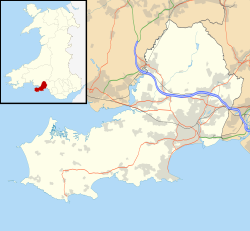City and County of Swansea
Dinas a Sir Abertawe (Welsh) | |
|---|---|
Clockwise from top: Swansea City Centre; Swansea Guildhall; St Thomas Church, Swansea; Maritime Quarter; Swansea Castle ruins; Three Cliffs Bay | |
| Motto(s): | |
 Swansea shown within Wales | |
| Coordinates: 51°37′N 3°57′W / 51.617°N 3.950°W | |
| Sovereign state | United Kingdom |
| Country | Wales |
| Preserved county | West Glamorgan |
| Town charter | 1158–1184 |
| City status | 1969 |
| Administrative HQ | Guildhall |
| Government | |
| • Type | Principal council |
| • Body | Swansea Council |
| • Control | Labour |
| • MPs | |
| • MSs | 3 MSs |
| Area | |
• Total | 146 sq mi (378 km2) |
| • Rank | 14th |
| Population (2022)[2] | |
• Total | 241,282 |
| • Rank | 2nd |
| • Density | 1,660/sq mi (639/km2) |
| Ethnicity (2021) | |
| • Ethnic groups | |
| Religion (2021) | |
| • Religion | List
|
| Time zone | UTC+0 (GMT) |
| • Summer (DST) | UTC+1 (BST) |
| Postcode areas | SA1–9 |
| Dialling codes | 01792 |
| ISO 3166 code | GB-SWA |
| GSS code | W06000011 |
| Website | swansea |
Swansea (/ˈswɒnzi/ SWON-zee; Welsh: Abertawe [abɛrˈtawɛ]) is a coastal city and the second-largest city of Wales. It forms a principal area, officially known as the City and County of Swansea (Welsh: Dinas a Sir Abertawe).[4]
The city is the twenty-fifth largest in the United Kingdom. Located along Swansea Bay in south-west Wales, with the principal area covering the Gower Peninsula, it is part of the Swansea Bay region and part of the historic county of Glamorgan and the ancient Welsh commote of Gŵyr.[5]
The principal area is the second most populous local authority area in Wales, with an estimated population of 241,282 in 2022.[2] Swansea, along with Neath and Port Talbot, forms the Swansea Urban Area, with a population of 300,352 in 2011. It is also part of the Swansea Bay City Region.
During the 19th-century industrial heyday, Swansea was the key centre of the copper-smelting industry, earning the nickname Copperopolis.[6][7]
- ^ "Council". Swansea Council. Retrieved 6 August 2024.
- ^ a b c "Mid-Year Population Estimates, UK, June 2022". Office for National Statistics. 26 March 2024. Retrieved 3 May 2024.
- ^ a b UK Census (2021). "2021 Census Area Profile – Swansea Local Authority (W06000011)". Nomis. Office for National Statistics. Retrieved 14 July 2024.
- ^ "Largest Cities in the UK". UKCities. Archived from the original on 22 October 2017. Retrieved 13 October 2017.
- ^ W.S.K. Thomas The History of Swansea from Rover Settlement to the Restoration. ISBS 0 86383 600 3
- ^ "Swansea". Encyclopædia Britannica. Archived from the original on 22 January 2009. Retrieved 9 January 2009.
- ^ Hughes, S. (2000) Copperopolis: landscapes of the early industrial period in Swansea Royal Commission on the Ancient and Historical Monuments of Wales






